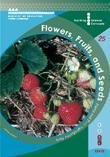You are here:
- Home »
- Teaching resources »
- Building Science Concepts »
- Titles and concept overviews »
- Flowers, Fruits, and Seeds

Book 25: Flowers, Fruits, and Seeds: Plants and Their Reproductive Parts
Synopsis
This unit gives children an opportunity to investigate the main reproductive parts of a flowering plant (tupu puāwai) – its flower (pua), fruit (hua), and seeds (kākano) – and to understand something of their functions. Children tend to think that plants grow mainly for people's benefit. The topic treated here underlines the concept that the whole of a plant's activity is directed towards leaving as many copies of itself as possible in the next generation. Flowers, fruit, and seeds are a means towards this end.
At this level, the focus is on a flowering plant's reproductive structures and the growth of new plants. The process of reproduction (including pollination) is covered in the levels 3 and 4 companion book, Making New Plants , Book 26 in this series.
Concept overview
Use the concept overview, which is also on the inside front cover of the book, as a reference for the concepts that relate to Flowers, Fruits, and Seeds: Plants and Their Reproductive Parts.
![]() Read the concept overview
(PDF 42 KB)
Read the concept overview
(PDF 42 KB)
Links with other titles in the series
Companion book:
- Book 26: Making New Plants (L3-4, Living World)
This book also has links with other books in the series:
-
Book 7: The Bush
(L3-4, Living World)
an introduction to the classification of plants
-
Book 23: Fresh Food
(L1-2, Living World)
the types of food we eat, including fruits and seeds
-
Book 35: Is This a Plant?
(L1-2, Living World)
an introduction to plants’ basic features and how they are classified
Assessment resources
Search the science section of the Assessment Resource Banks (ARB) website to find resources that assess the 'big idea' learning outcomes referred to in the concept overview for this title.

